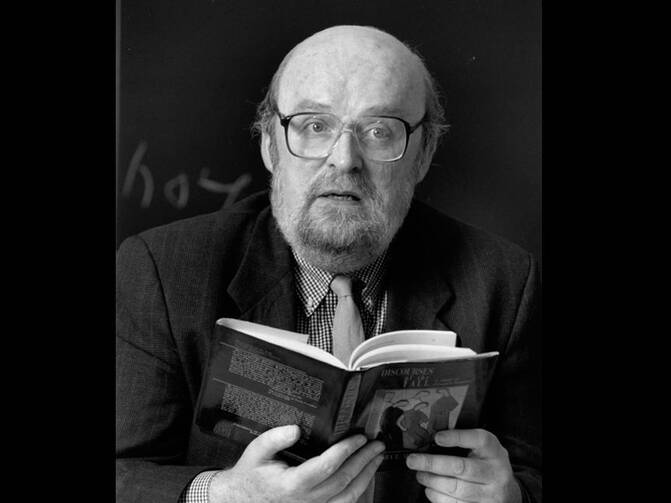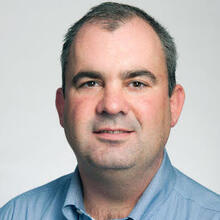“One of the most important theological voices of the late 20th century.” “More than a theologian. He was that rarer and more comprehensive figure: a Christian humanist.” “A theologian’s theologian.” “An emblematic figure in post-Vatican II Catholicism.” “The J. D. Salinger of the theological world.”
All of the above phrases have been used to describe the Rev. David Tracy, the renowned American theologian who died on April 29, 2025. I’m not sure what the last one means—not sure it’s a compliment—but they all represented attempts to capture the profound impact of Father Tracy’s scholarship and ministry over six decades as a teacher, writer and mentor to thousands of theologians.
Born in 1939 in Yonkers, N.Y., Tracy entered the minor seminary for the Archdiocese of New York, in 1952. In 1960, he was sent to Rome to study at the Pontifical Gregorian University and was ordained there in 1963, two weeks after the first decree of the Second Vatican Council was promulgated. (It’s the one on the media; no one has ever read it.) After receiving his licentiate in theology a year later, he served as a parish priest in Stamford, Conn., while working on his doctorate. (One of his parishioners? William F. Buckley Jr.)
The assignment—outside the Archdiocese of New York—was not an uncommon one in those days, as New York was experiencing a huge boom in vocations to the priesthood and sending newly ordained men to other dioceses across the Northeast. It was also a time of incredible intellectual ferment among the seminarians and young clergy in the archdiocese: There is quite a book to be written about the scholars that emerged from New York’s seminary system from 1950 to 1965. What was in the water?
Tracy’s first teaching assignment was at the Catholic University of America in 1967. A year later, he joined many of the other faculty in speaking out against Pope Paul VI’s recently promulgated encyclical against artificial birth control, “Humanae Vitae.” He was fired, along with 21 others; though they were later reinstated after a lawsuit, Tracy and Bernard McGinn (another alum of Dunwoodie and the Greg) moved on to the University of Chicago Divinity School, where they were the first two Catholic priests on the faculty. Tracy would teach there for the next 37 years.
As Ken Woodward noted recently in Commonweal, Tracy did not limit his intellectual partners to his fellow theologians. “He taught Greek tragedy and Shakespeare with the poet Richard Greene, another course on Stevens and Emily Dickinson with the poet Mark Strand, and American Religion with historian Martin Marty,” Woodward wrote. “At the University of Chicago’s Committee on Social Thought, he taught alongside an impressive array of professors, including the novelist Saul Bellow, the Polish historian and philosopher Leszek Kołakowski, and the classicist Allan Bloom.”
In 1984, the University of Chicago named him the Greeley Professor in Roman Catholic Studies (a chair endowed by his fellow Chicago scholar, the Rev. Andrew Greeley). In 1976-77, he served as the president of the Catholic Theological Society of America, which honored him with its John Courtney Murray Award in 1980. In 1982, he was elected to the American Academy of Arts and Sciences.
Tracy’s first book—O.K., second, after a book on the theology of his mentor at the Greg, Bernard Lonergan, S.J.—was 1975’s Blessed Rage for Order, an examination of the modern contexts in which religious pluralism emerged. By 1978, his theological star was in the ascendant to the degree that he co-edited a volume, Toward Vatican III: The Work That Needs To Be Done, with Johann Baptist Metz and Hans Küng.
Next came The Analogical Imagination in 1981. Concerned again with how to do systematic theology in a religiously pluralist world, the book also introduced some of the insights for which Tracy would become well known: the notion that religious traditions are heavily influenced by their “classics” (a person, event, book, symbol or piece of art that connects believers in every age with a “permanent timeliness” that provides shared meaning) and the observation that much religious thought is animated by an “analogical imagination” that sees similarity to and reflections of the divine in the world we experience every day. (Horrific oversimplifications, I know.)
In The Analogical Imagination, Tracy also wrote of the “three publics” to whom every teacher of theology speaks: the academy, the church and society at large. These are markedly different audiences, but any theological proposition ultimately becomes a matter for reflection and action for all three audiences to one degree or another. Theological reflection, in other words, has real-world consequences no matter what its original intended audience. “Theology,” he wrote, “is public discourse.”
The Analogical Imagination soon reached the status of a classic itself (though Avery Dulles, S.J., gave the book a somewhat unflattering review in America) and is used as an interpretive key in many fields beyond systematic theology. The aforementioned Father Greeley applied the framework of analogical imagination to the Catholic tradition in The Catholic Imagination, noting Catholic culture’s love of analogy, metaphor, image and story to convey meaning and proximity to God. (Think of it next time you read a classic Catholic novel.)
Many more books followed, including Talking About God: Doing Theology in the Context of Modern Pluralism (1983), A Short History of the Interpretation of the Bible and A Catholic Vision (1984), Plurality and Ambiguity (1987), Dialogue with the Other: The Inter-religious Dialogue (1990), On Naming the Present: God, Hermeneutics, and Church (1994) and two volumes of collected essays, Fragments and Filaments (2020).
In 1995, Bill Burrows of Orbis Books interviewed Tracy for America. In that long and wide-ranging interview, “Reasons to Hope for Reform,” Tracy noted that “we’re living in a period, especially since Vatican II, but even before it, where there has been a remarkable theological resurgence. It’s now happily no longer just Eurocentric but across the world. Catholicism has an enormous advantage in being so multicultural and related to so many cultures. Now we have genuine theologies from these cultures. There’s no excuse any longer for any theologian, especially a Catholic theologian, to be Eurocentric.”
He also argued that American Catholicism was developing in a distinctly different way from the church in European or other contexts. “Many European intellectuals—and this is not confined to intellectuals in the Vatican—have never understood the American church,” he said. “They tend to dismiss American culture. They tend not to see us as original.”
“This culture is, after all, the only major culture founded in modernity and the Enlightenment, with close ties to the Puritan side of the Reformed tradition. The American form of the Enlightenment was never anti-religious the way, for instance, the French Enlightenment was,” Tracy said. “I’ve always thought that Gertrude Stein spoke a good deal of truth when she said that in some ways the United States was the oldest culture because it was the first one that, from the beginning, had to deal with modernity—that is to say, the forces that now every culture is having to deal with.”
Tracy’s byline appeared in America only once, in 2018, when he wrote the introduction to the Metropolitan Museum of Art Costume Institute’s show, “Heavenly Bodies: Fashion and the Catholic Imagination” (yes, you read that right). In an excerpt from that introduction focusing on Michelangelo’s Sistine Chapel frescoes, he returned to some familiar themes:
Michelangelo’s theology is classically Catholic because it is both an analogical theology of creation-incarnation as anticipation of salvation as re-creation (as depicted in the Sistine ceiling) and a profound theology of the cross and of eschatology in the dialectical, sometimes violent imagery that saturates his “Last Judgment.” These two monumental frescoes exist together somewhat uneasily in the same space, theologically clashing even as they complement each other. Christianity cannot in fact be understood if one ignores the beauty and goodness in all creation or the tragic elements of suffering, evil and sin in all life. That is the Catholic analogical imagination.
In 1999, Tracy was invited to give the prestigious Gifford Lectures at the University of Edinburgh in Scotland. His topic, “This Side of God,” eventually became his final (unfinished) book project, what his friends called “The God Book”: It was to be a three-volume work in which he would focus on how we think about God in a world of religious pluralism, intellectual and ideological fragmentation and a loss of belief in universal truth-claims. He hoped, he said, to “name God in an age that cannot name itself.”
In 2020, Tracy published a two-volume collection of theological essays, Filaments and Fragments. In a review for America, Michael C. McCarthy, S.J., wrote that “[i]n Tracy we find someone who strives for a ‘public theology’ that resists the temptation to retire complacently to ‘some pleasant but deceptively secure reservation of the spirit.’ And he does it with such care, discipline and intentionality that we should both notice and imitate.”
Father Tracy died in Chicago on April 29, 2025. He was 86 years old. In a statement released by his cousins, nieces and nephews after his death, they wrote that he “will be remembered for his extraordinary body of work, the breadth of his influence, his rigorous explorations of the meaning and symbol of God in modern life, and his commitment to equality, social justice and interfaith and intercultural dialogue.”
•••
Our poetry selection for this week is “Clarification,” by Rachel E. Hicks. To read more about the selection process for this year’s prize, click here. Readers can view all of America’s published poems here.
Members of the Catholic Book Club: We are taking a hiatus while we retool the Catholic Book Club and pick a new selection.
In this space every week, America features reviews of and literary commentary on one particular writer or group of writers (both new and old; our archives span more than a century), as well as poetry and other offerings from America Media. We hope this will give us a chance to provide you with more in-depth coverage of our literary offerings. It also allows us to alert digital subscribers to some of our online content that doesn’t make it into our newsletters.
Other recent Catholic Book Club columns:
- The priest-detectives of American fiction
- Riley Hughes, an unsung literary jack of all trades
- The history (and future) of covering conclaves
- Remembering Peru’s literary master, Mario Vargas Llosa
- Pope Francis the bookworm
Happy reading!
James T. Keane








